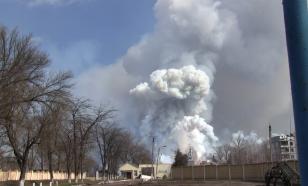Britain's farmers brace themselves as foot-and-mouth follows floods
Farmer Michael Fordham remembers all too well the ravages of the foot-and-mouth epidemic that swept Britain in 2001 - millions of cattle culled and a personal financial burden almost impossible to bear.

So six years later, Fordham, who runs a farm with 90 head of cattle near the town of Uckfield in southern England, was stunned to hear of the latest outbreak of the highly contagious disease.
"I couldn't believe it; it was absolutely staggering to think it could happen again," he said this week. "And on top of all the flooding and bad weather."
Severe floods in June and July across the country had already proved costly for farmers. Fordham found out about the foot-and-mouth outbreak when he switched on the TV after a day spent in the fields doing long-overdue work, such as haymaking, that had been prevented by the rising waters.
Now, the swift ban imposed by the government on all movement of cattle, sheep, goats and pigs nationwide threatens the viability of Fordham's small store at Bradford Farm. He was unable to send selected cattle to the slaughterhouse this week.
At the national level, the Farmers Union said the government's voluntary ban on exports of livestock, meat and milk - imposed Saturday, a day after the discovery of the disease in at least two animals at a farm in Surrey, southwest of London - would have cost millions of pounds already.
The European Union, which was accused of retaining its 2001 ban for longer than necessary, announced its own ban on Monday and each week it lasts is expected to cost Britain millions more. A long-term ban is also likely to cause the domestic price of British meat to plummet, further crimping farmers' profits.
"We know from long and bitter experience that a ban on exports leads to very low prices," said National Farmers' Union spokesman Anthony Gibson. "Further price cuts could be the last straw for an awful lot of people."
The EU attempted to ease some of the economic impact by exempting from its ban some products it deems safe, including those produced before July 15 that were treated in a way to inactivate the virus and those manufactured in Great Britain but derived from animals reared outside its territory.
Britain's Meat and Livestock Commission said cattle and beef exports in 2006 were worth more than 100 million pounds (then about EUR 148 million; US$196 million). Sheep and sheepmeat exports were valued at almost 250 million pounds (then about EUR 371 million; US$490 million), while pig and pork exports accounted for around 175 million pounds (then about EUR 259 million; US$343 million).
Exports of British beef resumed only in May of last year, reversing a 10-year ban that followed the discovery of a link between bovine spongiform encephalopathy, or mad cow disease, and the variant Creutzfeldt-Jakob Disease in humans.
And many farmers are still recovering from the domestic effects of the outbreak of foot-and-mouth in 2001, when 7 million animals were slaughtered, many on pyres, costing the economy around 8.5 billion pounds.
"By its nature, farming is a long-term business, with sheep flocks just coming out of the after-effects of 2001," said Malcolm Corbett, the head of the National Farmers Union. "This is a real body blow to the livestock industry."
Alongside domestic sales and exports, tourism could be hit by an ongoing alert.
Former Prime Minister Tony Blair's decision to shut down large swathes of the countryside and appeal for people to stay in the cities to avoid spreading the disease was blamed for worsening the 2001 outbreak's impact on tourism.
This time, while keeping a tight reign on livestock movements, Prime Minister Gordon Brown has stressed the countryside remains open to tourists.
Whether the current scare reaches the proportions of the previous epidemic depends on successful containment.
"It's very early days to try to gauge the effects," said Investec economist David Page. "What we are hoping to avoid is a situation as bad as 2001."
Foot-and-mouth, an infectious disease that mainly affects cloven-hoofed animals, can be fatal among young hogs, sheep and cattle. Infection in older animals causes blistering on the mouth and tongue, reducing milk and meat production. Foot-and-mouth can be carried by wind and on the vehicles and clothes of people who come into contact with infected animals.
Farmers have so far welcomed the government's moves to contain the outbreak - the investigation has focused on a suspected link between the cases and a vaccine laboratory - and Brown thanked them for their "forbearance."
All Fordham can do in the coming days is keep a very close eye on his cattle - it can take 10 days for symptoms to show in infected animals - and hope the virus does not spread.
"You just pray when you see something resembling the symptoms that it's not foot-and-mouth," he said Monday. "We just hope this is an isolated incident."
Subscribe to Pravda.Ru Telegram channel, Facebook, RSS!


